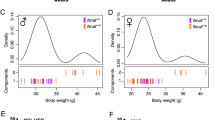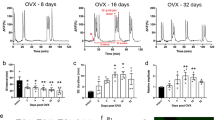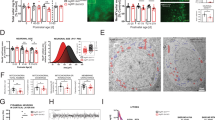Abstract
Mammalian circadian rhythms of activity are generated within the suprachiasmatic nucleus (SCN). Transcripts from the imprinted, paternally expressed Magel2 gene, which maps to the chromosomal region associated with Prader-Willi Syndrome (PWS), are highly enriched in the SCN. The Magel2 message is circadianly expressed and peaks during the subjective day. Mice deficient in Magel2 expression entrain to light cycles and express normal running-wheel rhythms, but with markedly reduced amplitude of activity and increased daytime activity. These changes are associated with reductions in food intake and male fertility. Orexin levels and orexin-positive neurons in the lateral hypothalamus are substantially reduced, suggesting that some of the consequences of Magel2 loss are mediated through changes in orexin signaling. The robust rhythmicity of Magel2 expression in the SCN and the altered behavioral rhythmicity of null mice reveal Magel2 to be a clock-controlled circadian output gene whose disruption results in some of the phenotypes characteristic of PWS.
This is a preview of subscription content, access via your institution
Access options
Subscribe to this journal
Receive 12 print issues and online access
$209.00 per year
only $17.42 per issue
Buy this article
- Purchase on Springer Link
- Instant access to full article PDF
Prices may be subject to local taxes which are calculated during checkout




Similar content being viewed by others
References
Goldstone, A.P. Prader-Willi syndrome: advances in genetics, pathophysiology and treatment. Trends Endocrinol. Metab. 15, 12–20 (2004).
Runte, M. et al. The IC-SNURF-SNRPN transcript serves as a host for multiple small nucleolar RNA species and as an antisense RNA for UBE3A. Hum. Mol. Genet. 10, 2687–2700 (2001).
Bressler, J. et al. The SNRPN promoter is not required for genomic imprinting of the Prader-Willi/Angelman domain in mice. Nat. Genet. 28, 232–240 (2001).
Yang, T. et al. A mouse model for Prader-Willi syndrome imprinting-centre mutations. Nat. Genet. 19, 25–31 (1998).
Gerard, M., Hernandez, L., Wevrick, R. & Stewart, C.L. Disruption of the mouse necdin gene results in early post-natal lethality. Nat. Genet. 23, 199–202 (1999).
Pagliardini, S., Ren, J., Wevrick, R. & Greer, J.J. Developmental abnormalities of neuronal structure and function in prenatal mice lacking the prader-willi syndrome gene necdin. Am. J. Pathol. 167, 175–191 (2005).
Tsai, T.F., Jiang, Y.H., Bressler, J., Armstrong, D. & Beaudet, A.L. Paternal deletion from Snrpn to Ube3a in the mouse causes hypotonia, growth retardation and partial lethality and provides evidence for a gene contributing to Prader-Willi syndrome. Hum. Mol. Genet. 8, 1357–1364 (1999).
Muscatelli, F. et al. Disruption of the mouse Necdin gene results in hypothalamic and behavioral alterations reminiscent of the human Prader-Willi syndrome. Hum. Mol. Genet. 9, 3101–3110 (2000).
Ren, J. et al. Absence of Ndn, encoding the Prader-Willi syndrome-deleted gene necdin, results in congenital deficiency of central respiratory drive in neonatal mice. J. Neurosci. 23, 1569–1573 (2003).
Boccaccio, I. et al. The human MAGEL2 gene and its mouse homologue are paternally expressed and mapped to the Prader-Willi region. Hum. Mol. Genet. 8, 2497–2505 (1999).
Lee, S. et al. Expression and imprinting of MAGEL2 suggest a role in Prader-willi syndrome and the homologous murine imprinting phenotype. Hum. Mol. Genet. 9, 1813–1819 (2000).
Lee, S., Walker, C.L. & Wevrick, R. Prader-Willi syndrome transcripts are expressed in phenotypically significant regions of the developing mouse brain. Gene Expr. Patterns 3, 599–609 (2003).
Panda, S. et al. Coordinated transcription of key pathways in the mouse by the circadian clock. Cell 109, 307–320 (2002).
Card, J.P. Pseudorabies virus and the functional architecture of the circadian timing system. J. Biol. Rhythms 15, 453–461 (2000).
Ibata, Y. et al. Functional morphology of the suprachiasmatic nucleus. Front. Neuroendocrinol. 20, 241–268 (1999).
Silver, R. & Schwartz, W.J. The suprachiasmatic nucleus is a functionally heterogeneous timekeeping organ. Methods Enzymol. 393, 451–465 (2005).
Yoo, S.H. et al. PERIOD2:LUCIFERASE real-time reporting of circadian dynamics reveals persistent circadian oscillations in mouse peripheral tissues. Proc. Natl. Acad. Sci. USA 101, 5339–5346 (2004).
Goldstone, A.P. The hypothalamus, hormones, and hunger: alterations in human obesity and illness. Prog. Brain Res. 153, 57–73 (2006).
Sakurai, T. Roles of orexin/hypocretin in regulation of sleep/wakefulness and energy homeostasis. Sleep Med. Rev. 9, 231–241 (2005).
Hara, J., Yanagisawa, M. & Sakurai, T. Difference in obesity phenotype between orexin-knockout mice and orexin neuron-deficient mice with same genetic background and environmental conditions. Neurosci. Lett. 380, 239–242 (2005).
Willie, J.T. et al. Distinct narcolepsy syndromes in Orexin receptor-2 and Orexin null mice: molecular genetic dissection of Non-REM and REM sleep regulatory processes. Neuron 38, 715–730 (2003).
Davies, W., Isles, A.R. & Wilkinson, L.S. Imprinted gene expression in the brain. Neurosci. Biobehav. Rev. 29, 421–430 (2005).
Keverne, E.B., Fundele, R., Narasimha, M., Barton, S.C. & Surani, M.A. Genomic imprinting and the differential roles of parental genomes in brain development. Brain Res. Dev. Brain Res. 92, 91–100 (1996).
Lefebvre, L. et al. Abnormal maternal behaviour and growth retardation associated with loss of the imprinted gene Mest. Nat. Genet. 20, 163–169 (1998).
Li, L. et al. Regulation of maternal behavior and offspring growth by paternally expressed Peg3. Science 284, 330–333 (1999).
Kontgen, F., Suss, G., Stewart, C., Steinmetz, M. & Bluethmann, H. Targeted disruption of the MHC class II Aa gene in C57BL/6 mice. Int. Immunol. 5, 957–964 (1993).
Herzog, E.D., Aton, S.J., Numano, R., Sakaki, Y. & Tei, H. Temporal precision in the mammalian circadian system: a reliable clock from less reliable neurons. J. Biol. Rhythms 19, 35–46 (2004).
Simmons, D.M., Arriza, J.L. & Swanson, L.W. A complete protocol for in situ hybridization of messenger RNAs in brain and other tissue with radio-labeled single stranded RNA probe. J. Histotechnol. 12, 169–180 (1989).
Paxinos, G. & Tork, I. Neuroanatomical nomenclature. Trends Neurosci. 13, 169 (1990).
Acknowledgements
This work was supported by the Intramural Research Program of the National Cancer Institute, NIH grants MH63104 (EDH) and EY14988, and the Culpeper Medical Scientist Award of the Rockefeller Brothers Foundation (to R.N.V.G.). We thank R. Seeley for advice, R. Awashti for help in the fertility assays, and R. Frederickson for help in preparation of the figures.
Author information
Authors and Affiliations
Contributions
R.N.V.G., S.V.K., E.D.H., R.W., J.B.H., L.J.M. and C.L.S. designed the experiments, S.V.K., S.P., M.P.H. and J.W.B. performed the experiments, and R.V.G., E.D.H. and C.L.S. wrote the paper.
Note: Supplementary information is available on the Nature Genetics website.
Corresponding author
Supplementary information
Supplementary Text and Figures
Supplementary Figures 1–3, Supplementary Tables 1–4 (PDF 451 kb)
Rights and permissions
About this article
Cite this article
Kozlov, S., Bogenpohl, J., Howell, M. et al. The imprinted gene Magel2 regulates normal circadian output. Nat Genet 39, 1266–1272 (2007). https://doi.org/10.1038/ng2114
Received:
Accepted:
Published:
Issue Date:
DOI: https://doi.org/10.1038/ng2114
This article is cited by
-
Imprinted genes and the manipulation of parenting in mammals
Nature Reviews Genetics (2023)
-
Circadian disruption: from mouse models to molecular mechanisms and cancer therapeutic targets
Cancer and Metastasis Reviews (2023)
-
Early life oxytocin treatment improves thermo-sensory reactivity and maternal behavior in neonates lacking the autism-associated gene Magel2
Neuropsychopharmacology (2022)
-
Oxytocin-based therapies for treatment of Prader-Willi and Schaaf-Yang syndromes: evidence, disappointments, and future research strategies
Translational Psychiatry (2022)
-
Comparison of mouse models reveals a molecular distinction between psychotic illness in PWS and schizophrenia
Translational Psychiatry (2021)



